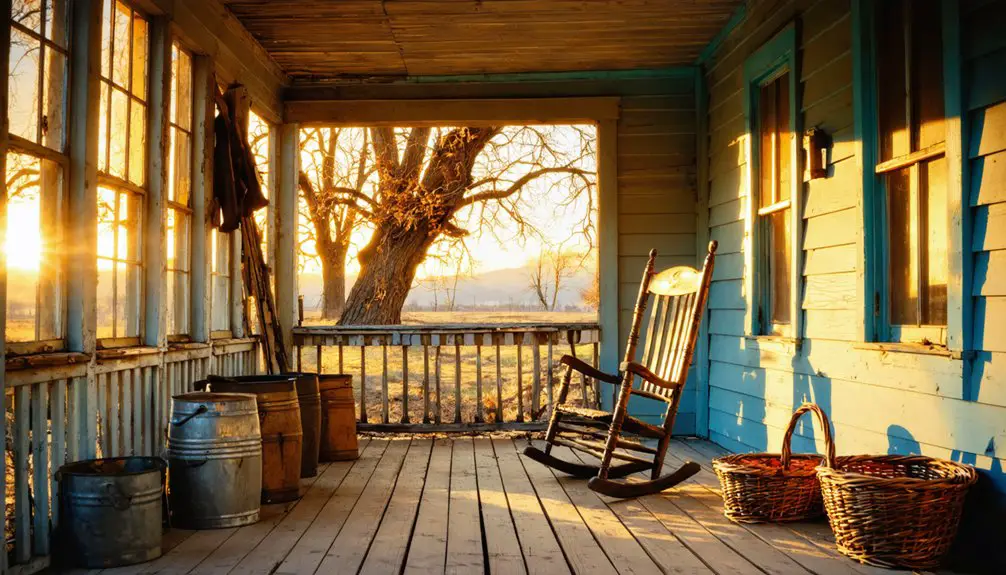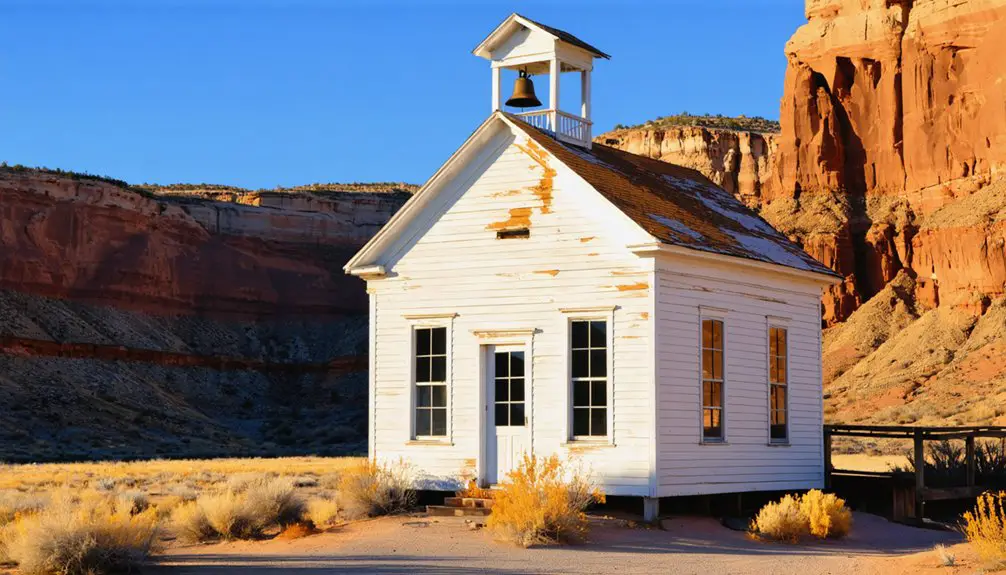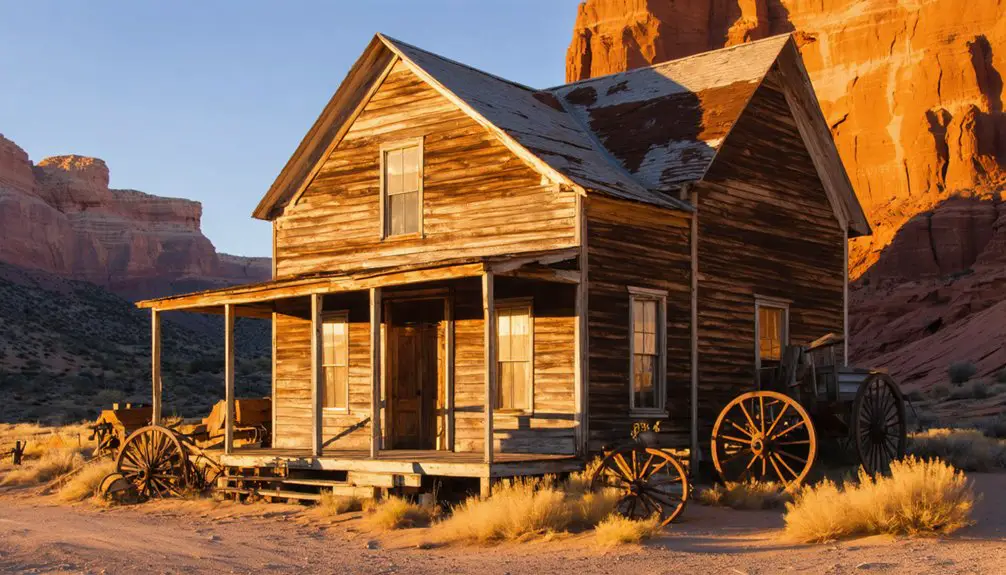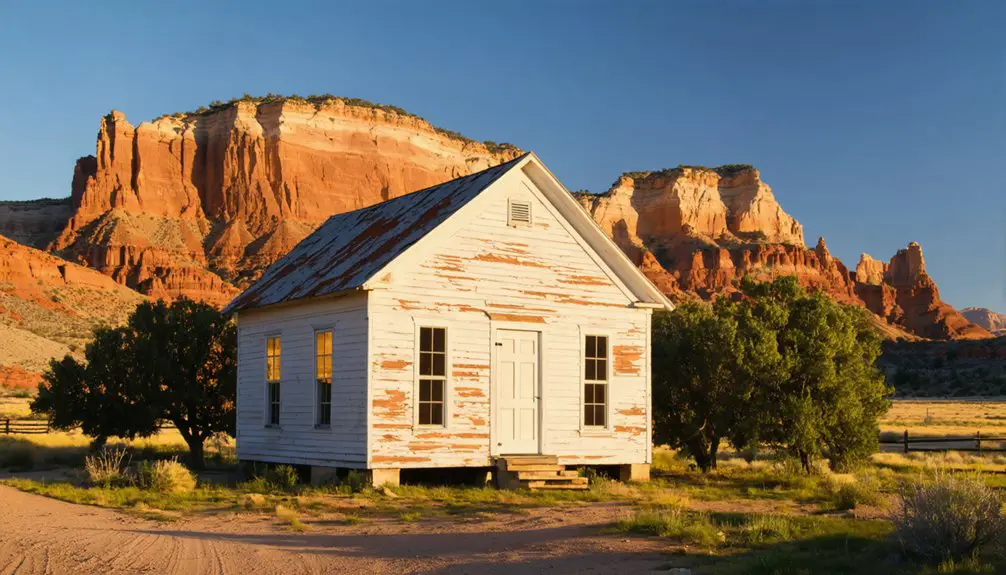You’ll find Fruita, Utah’s most picturesque ghost town, nestled within Capitol Reef National Park. Established in 1880 by Mormon pioneers, this remote settlement transformed harsh desert into a thriving agricultural community through innovative irrigation techniques. The town never grew beyond ten families but maintained flourishing orchards until its mid-20th century abandonment. Today, you can explore preserved pioneer structures, including the historic Gifford House and schoolhouse, while discovering how this remarkable desert oasis once flourished against impossible odds.
Key Takeaways
- Fruita, established in 1880, was a small Mormon settlement that never exceeded ten families before becoming part of Capitol Reef National Park.
- The community thrived through fruit orchards and advanced irrigation systems until economic challenges and isolation led to its abandonment.
- Historic structures like the Gifford House and schoolhouse remain preserved, showcasing pioneer life in this former settlement.
- Fruita’s 200-300 acres of cultivated farmland and orchards are maintained today as part of the national park’s cultural landscape.
- While technically a ghost town, Fruita differs from typical abandoned settlements as its orchards and buildings are actively preserved for visitors.
The Birth of a Mormon Settlement
While Mormon expansion into Utah’s remote regions gained momentum in the late 19th century, the settlement of Fruita emerged in 1880 at a strategic location where the Fremont River met Sulphur Creek.
You’ll find that this Mormon migration followed careful planning by church officials who sought areas with reliable water sources in Utah’s challenging terrain.
Led by pioneer Nels Johnson, settlers transformed the area through innovative agricultural techniques, harnessing river water for irrigation in the arid landscape.
Mormon settlers, guided by Nels Johnson, revolutionized the harsh desert terrain by developing advanced irrigation methods from river resources.
Originally called Junction, the settlement was renamed Fruita in 1902 to reflect its thriving orchards.
The site’s unique geography, with canyon walls that reflected heat onto the fertile soil, created ideal growing conditions.
Though never home to more than ten families, the community established itself under local Mormon leadership, creating a self-sustaining outpost in this remote corner of Utah.
The community developed a thriving barter-based economy that helped residents maintain stability even during difficult economic times.
Johnson’s agricultural expertise led him to plant diverse fruit orchards that included apples, peaches, pears, plums, walnuts, and almonds.
Life in Utah’s Desert Oasis
You’d find Fruita as a striking contrast to Utah’s arid landscape, where the Fremont River transformed 200-300 acres into a fertile paradise of orchards and crops.
The tight-knit Mormon community of never more than ten families worked together, sharing labor and resources through a barter system while tending to their fruit trees, livestock, and vegetable gardens. Today, visitors can experience a taste of pioneer life at the historic Gifford House while exploring the district. The community raised diverse livestock including cows and sheep, providing sustenance for the isolated settlement.
Your glimpse into their daily life would reveal a self-sufficient society where religious gatherings, education, and social activities centered around multi-purpose buildings like the 1896 schoolhouse, fostering strong bonds despite their extreme isolation.
Water-Fed Desert Paradise
Although Fruita sits in Utah’s arid landscape, this desert oasis flourished through an intricate network of water management that transformed barren terrain into fertile farmland.
You’ll find evidence of sophisticated irrigation techniques dating back centuries, with ancient ditches carefully carved to follow the natural contours rather than cutting through obstacles.
The community’s water management evolved from early settlers’ use of the Fremont River to a complex system of reservoirs and irrigation channels. Similar to how the City of Fruita utilized a 23-mile wooden pipeline to transport water in the early 1900s.
By the 1960s, modern infrastructure improvements included new ditches, flumes, and culverts that efficiently delivered water throughout the region.
The results were remarkable – thriving orchards produced apples, peaches, and plums, while fields yielded sorghum and alfalfa.
This mastery of water resources turned an unforgiving desert into a productive agricultural haven.
Pioneer Community Spirit
Resilience defined the pioneer spirit of Fruita’s close-knit Mormon community, where no more than ten families carved out a living in Utah’s desert landscape.
Under the guidance of their Presiding Elder, you’d find neighbors working together to maintain essential irrigation systems and share agricultural expertise. Similar to William E. Pabor’s vision, their focus was on developing productive orchards and agricultural lands. Their community resilience shone through neighborly cooperation, as families united for fruit harvests and orchard maintenance. Like the Lapham pioneers, they welcomed weary travelers with food and shelter.
Isolation strengthened their bonds, with the challenging Blue Dugway wagon track serving as their primary connection to the outside world.
You’ll discover how they adapted through bartering goods and services, creating a self-sufficient ecosystem where each family contributed unique skills. This interdependence, rooted in Mormon values, helped them overcome the harsh desert conditions while building a thriving agricultural settlement.
Daily Agricultural Rhythms
While the harsh desert climate posed constant challenges, Fruita’s pioneering families established intricate daily agricultural rhythms centered around their precious fruit orchards. You’d find them tending to nearly 2,000 heirloom trees using traditional 19th-century farming methods, carefully timing their orchard maintenance with the Fremont River’s flow. Using gravity-fed irrigation ditches, early settlers distributed water efficiently throughout their growing fields.
Their days revolved around seasonal harvests – picking cherries and apricots in early summer, followed by peaches and pears later. You’d see them gathering fruit before full ripeness for transport to markets in Price and Richfield. Today, visitors can explore the Gifford Homestead site, built in 1908, to experience this rich agricultural heritage.
After harvest, they’d preserve their bounty through canning, making pies, and crafting homemade ice cream. Despite their isolation, these resilient farmers created a thriving desert oasis through their mastery of irrigation and dedicated orchard care.
Agricultural Success Against the Odds
Despite harsh desert conditions and frequent flooding from the Fremont River, Fruita’s pioneering farmers transformed roughly 300 acres into a thriving agricultural oasis.
You’ll find their remarkable success stemmed from adapting to the farming challenges through strategic crop selection and resourceful irrigation methods.
These determined settlers overcame isolation and transportation difficulties by developing crop resilience. They grew everything from sorghum for molasses production to diverse fruit orchards featuring apples, peaches, pears, and cherries.
Through innovative farming and diverse crop selection, Fruita’s pioneers created a self-sustaining oasis despite their remote desert location.
While the arid plateau landscape posed significant obstacles, Fruita’s relatively long growing season proved advantageous. The community maximized their limited water supply from the Fremont River, creating a verdant paradise that earned its reputation as an “Eden” in the desert. A small schoolhouse was constructed to educate the children of the farming families.
Their agricultural achievements demonstrate how innovation and persistence can triumph over environmental adversity.
Daily Routines and Social Gatherings

You’d find daily life in Fruita revolved around communal meals and social gatherings, where residents would share food while enjoying singing, card games, and traditional quilting activities.
The one-room schoolhouse served as the heart of community life, hosting everything from baseball games to religious services and educational lessons.
These gatherings weren’t just social occasions but essential survival mechanisms that helped the isolated community maintain its cohesion through shared entertainment, worship, and learning.
Community bonds in Fruita flourished through frequent communal suppers and social gatherings that brought together the settlement’s small population of no more than ten families.
You’ll find that shared recipes and communal feasts were central to the town’s social fabric, often taking place at the Gifford House or schoolhouse.
These gatherings fostered cooperation and fellowship through:
- Evening meals combined with singing, games, and card playing
- Seasonal celebrations following fruit harvests from the orchards
- Quilting circles and reading sessions that enriched social interactions
- Religious services and community meetings that blended worship with fellowship
The practice of sharing meals extended beyond simple dining, as families would exchange food and labor through bartering systems, creating a self-sustaining community despite their geographical isolation.
Games and Entertainment Activities
While isolated from larger settlements, Fruita’s residents cultivated a rich social life centered around diverse recreational activities and gatherings.
You’d find yourself joining spirited baseball games near the orchards or participating in lively card games at the Gifford House. Community games often took place in the one-room schoolhouse, which transformed into a vibrant social hub for dances and entertainment.
During your leisure time, you could engage in quilting circles or join reading groups that reflected the community’s value of literacy.
Social gatherings frequently combined work with pleasure – fruit picking sessions evolved into festive group activities, while cooperative work parties turned into evening entertainment with storytelling and singing.
The nearby Fremont River and desert landscape provided natural spaces for outdoor exploration and hiking adventures.
Religious and Educational Gatherings
Life in Fruita centered around the one-room schoolhouse, which served as both an educational facility and religious gathering place for the small Mormon settlement.
You’ll find the preserved legacy of both religious practices and educational traditions deeply woven into the community’s history.
The schoolhouse anchored daily routines for the tight-knit population of no more than ten families, reflecting their commitment to both learning and faith:
- Children studied reading, writing, arithmetic, history, and geography
- A visiting Bishop from Torrey led occasional religious services
- The Presiding Elder oversaw the relaxed Mormon community
- Social gatherings merged with spiritual events, featuring shared meals and community dances
The National Park Service’s 1966 renovation of the schoolhouse preserved this essential piece of Fruita’s heritage, where education and worship once united the isolated settlement.
The Heart of Community: The Schoolhouse

Standing as a symbol to frontier education, Fruita’s one-room schoolhouse served as the community’s cultural anchor from 1896 to 1941.
You’ll find schoolhouse memories etched into every detail, from the distinctive flagpole to the restored 1930s interior. The building hosted 8 to 26 students across eight grades, with teachers like twelve-year-old Nettie Behunin and Janice Oldroyd Torgerson shaping young minds.
Beyond education, community gatherings transformed the space into a vibrant social hub, hosting Sunday school sessions and Saturday night festivities.
The National Park Service’s 1989 restoration preserves this landmark to Mormon educational values and frontier adaptability.
Today, as part of Capitol Reef National Park, you can explore this National Register of Historic Places site and experience a slice of Utah’s rural educational heritage.
Architectural Heritage and Notable Buildings
The architectural legacy of Fruita reveals itself through a collection of pioneer-era structures that speak to Mormon settlement ingenuity.
The historical significance of these buildings showcases the resourceful architectural styles developed by isolated frontier communities using local materials and practical designs.
- The Gifford House, built in 1908, stands as the premier example of residential architecture, featuring local stone and wood construction typical of Mormon pioneer settlements.
- Agricultural outbuildings, including barns and storage sheds, demonstrate the community’s self-sufficient farming lifestyle.
- The multipurpose schoolhouse served as both an educational facility and religious gathering space, reflecting efficient use of limited resources.
- Infrastructure like the Blue Dugway, constructed in 1884, represents the community’s determination to establish essential transportation links despite challenging terrain.
The Path to Abandonment

Despite its idyllic nickname as the “Eden of Wayne County,” Fruita’s path toward abandonment stemmed from a complex web of geographic isolation, economic constraints, and demographic limitations.
You’ll find that isolation challenges severely restricted the community’s access to markets and essential services, with travel times exceeding 1.5 hours just to cover 10 miles to nearby Torrey.
The settlement’s agricultural dependency on fruit orchards provided the main source of cash income, but this narrow economic base proved unsustainable.
With a population never exceeding ten families, Fruita lacked the critical mass needed to maintain basic services – even its school closed in the 1940s as residents dwindled.
Legacy Within Capitol Reef National Park
Within Capitol Reef National Park‘s sprawling landscape, Fruita’s legacy endures as a carefully preserved piece of pioneer history.
You’ll find this 200-acre historic district offering authentic glimpses into Utah’s pioneer agriculture through its restored structures and living orchards.
The preservation of Fruita heritage stands apart from typical ghost towns through:
- The 1896 schoolhouse, renovated in 1966, which served as the community’s educational and social hub
- The 1908 Gifford House, now a museum showcasing rural settler life
- Original fruit orchards that still produce harvests, continuing the area’s agricultural tradition
- The Fruita Campground, allowing you to experience both natural wonders and historical sites
This former “Eden of Wayne County” now serves as an essential educational resource, demonstrating the delicate balance between human settlement and environmental preservation within Capitol Reef’s boundaries.
Preserving Pioneer History Today

Modern preservation efforts bring Fruita’s pioneer heritage to life through carefully coordinated initiatives spanning multiple organizations and approaches.
You’ll find historical preservation manifested in the maintained Gifford House, Behunin’s cabin, and pioneer-built orchards that serve as living exhibits of early settlement life.
Community involvement plays a crucial role through organizations like the Wayne Wonderland Club, which champions the protection of Fruita’s structures and landscapes.
Local passion drives Fruita’s preservation, with dedicated groups like the Wayne Wonderland Club safeguarding our pioneer heritage.
You can experience this history firsthand through ranger-led tours, historic reenactments, and interpretive trails that showcase pioneer lifestyles and agricultural practices.
The National Park Service works alongside state preservation offices to maintain infrastructure while protecting historic integrity.
Through oral histories, archaeological research, and digital archiving, Fruita’s pioneer legacy continues to educate and inspire visitors about early Utah settlement.
Frequently Asked Questions
Are There Any Reported Ghost Sightings or Paranormal Activities in Fruita?
You won’t find documented ghost encounters or paranormal investigations in this historic site. While other Utah ghost towns have spooky tales, Fruita’s significance lies in its preserved buildings and agricultural past.
What Happened to the Original Mormon Families After Leaving Fruita?
You’ll find that Mormon migration led families to resettle in nearby towns like Torrey and Bicknell, where they continued farming traditions and strengthened their religious communities, preserving Fruita’s legacy through their descendants.
Can Visitors Pick Fruit From the Historic Orchards Today?
Among 1,900 heirloom trees, you’ll find plenty of fruit picking opportunities in the historic orchards. You’re welcome to harvest ripe fruit when “U-Pick” signs are posted, but you’ll need to pay at self-service stations.
Did Native Americans Interact With Fruita Settlers During Its Active Years?
You’ll find limited evidence of cultural exchange or trade relations between Native Americans and Fruita’s settlers, though archaeological records show Native peoples inhabited the area before Mormon pioneers established their settlement.
What Was the Average Property Value of Fruita Homes Before Abandonment?
As you’d explore those weathered historical homes nestled against red cliffs, you’ll find no clear property valuation records exist. The isolated community’s barter economy prevented establishment of standard market prices.
References
- https://kool1079.com/ghost-town-fruita-utah/
- https://www.legendsofamerica.com/ut-fruita/
- https://npshistory.com/publications/care/clr.pdf
- https://www.nps.gov/care/learn/historyculture/fruita.htm
- https://capitolreefcountry.com/ghost-towns/
- https://utahguide.com/national-parks/capitol-reef/history/
- https://www.nps.gov/care/learn/historyculture/pioneer-settlers.htm
- https://capitolreefcountry.com/blog/fruita-historic-district-a-step-back-in-time/
- https://www.nps.gov/care/learn/historyculture/giffordhomestead.htm
- https://www.fruita.org/638/History-Challenges



